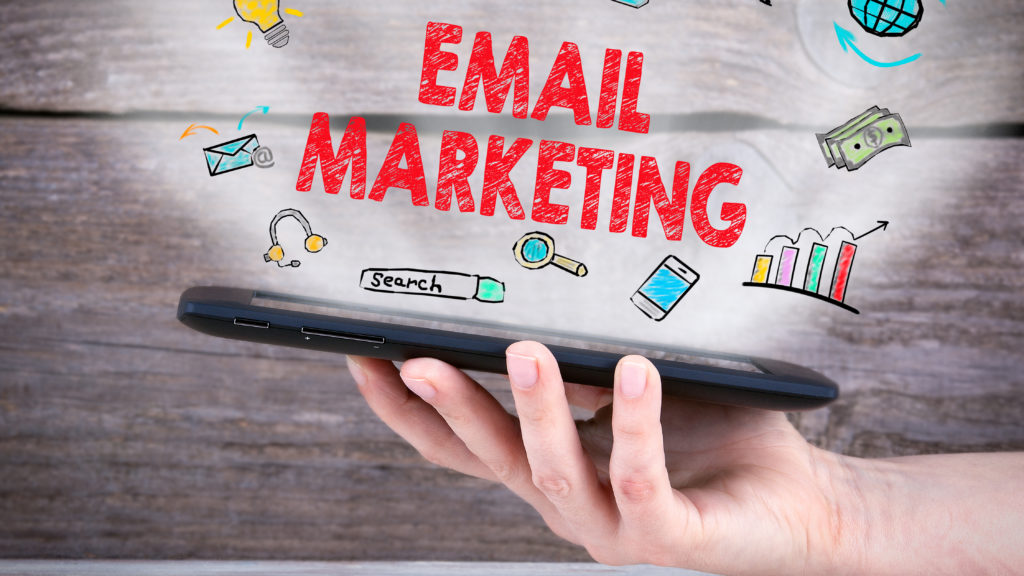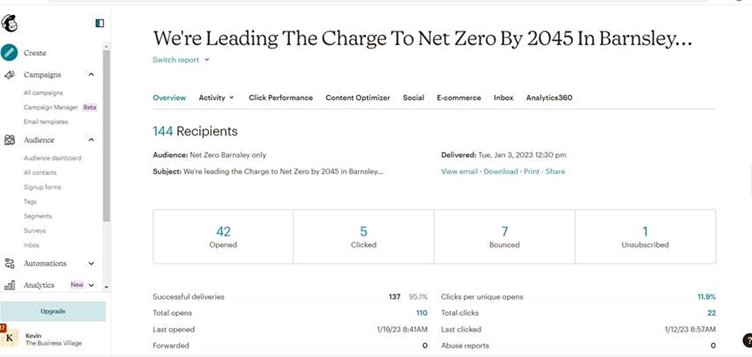
With the rise in popularity of social media, it would be easy to believe that email marketing has had its day. But it’s still one of the most effective digital marketing strategies you can use. The Content Marketing Institute produce an annual report. And, the 2022 report showed 69% of B2B marketers regularly use email newsletters.
In 2020, approximately 306 billion emails were sent and received every day worldwide. This figure is only projected to increase. So it makes sense to take advantage of this trend in your marketing.
Email marketing is a way of providing information about your company via email. It’s a great way to develop relationships with your current customers. And it’s also something you can use to reach out to potential new customers.
But it’s more than simply delivering messages to people’s inboxes.
Through creating a personalised connection, you can build relationships with people. And, by giving subscribers helpful information, you can help them achieve their goals.
Email marketing can help:
But why spend time and money on email marketing when you can share the same information on social media?
Research from Statista shows that for online advertising, email has a higher CTR (click through rate) than social media. More importantly, email marketing, is not subject to the whims and ever changing algorithms of social media. You own your email list. But, if Instagram shut down tomorrow, you’d lose all your followers overnight.
With email marketing, you’re targeting people directly rather than hoping they’ll see a social media post. But remember, none of us give away our email address lightly. So, treat your email list kindly and build relationships.
Email marketing falls into either warm or cold outreach.
Warm outreach:
Warm outreach is communicating with someone who already knows you. It could have been via attending one of your webinars or downloading a free template. Or they could be previous customers and other business connections.
The idea behind a warm email is to solve the recipient’s pain points. Or to nurture their interest in your company and share more about you and your brand.
Weekly or monthly newsletters are great email marketing methods for warm outreach.
Cold outreach:
Cold outreach is a way of growing your business via emailing a list of potential new customers.
The first step is for data collectors to research and collate a list of contacts. Importantly, the list must include useful information on the recipient.
By including personalised details in the body of your email, you can avoid looking like spam. At the very least, include the recipient’s name and company name. But, if you know what they’re looking for and what may be useful to them, you stand a better chance of a positive response.
Kim Crowther is Client Services Director for IOL Marketing, specialists in email marketing. She recommends sending cold outreach emails in plain text to help avoid company spam filters.
“If you want to do more campaigns and grow your business via email, it could make sense to use a company like ours. Sending a higher volume of cold outreach emails will mean increased leads. But that’s where it can get complex as platforms charge you to hold data there. We work with businesses selling their products and services nationwide to other businesses. Typical sectors include advertising, digital, and manufacturing suppliers. Once you send a campaign, it’s important to track and follow up those not responding. It can mean a huge amount of work which can be difficult for small teams to manage.”
For those choosing to DIY, one of the first steps will be choosing your email marketing software. But an internet search for the best provider will uncover a bewildering list of options.
We’ve summarised some of the better known ones below.
| Provider | Cost | Number of subscribers | Number of emails | Notes |
| Mailchimp | Free for up to 500 subscribers | 500 on free plan | 2,500 per month on the free plan | Pricing changed in 2019, the free legacy plan has 2,000 subscribers |
| HubSpot | Free to start | Unlimited | 2,000 per month on the free plan | Link to CRM and advanced features for extra cost |
| MailerLite | Free for up to 1,000 subscribers | 1,000 on free plan | 12,000 per month on the free plan | Different pricing tiers as subscribers increase |
| DotDigital | 3 pricing tiers, contact for quote | ? | ? | Free trial available |
| Flodesk | $38 per month | Unlimited | Unlimited | No tiers, just one unlimited plan |
| ConvertKit | Free for up to 1,000 subscribers | 1,000 on free plan | Unlimited | Different pricing tiers as subscribers increase |
When comparing platforms, you may think cheapest is best. But it’s important to look at the bigger picture and think about what happens as your list grows.
For example, Mailchimp is widely used as a free email marketing platform. But many find the interface complex and clunky. MailerLite and ConvertKit have free plans for up to 1,000 subscribers. But check how much it will cost once you go over that number. Flodesk will incur a cost from the beginning, but that stays the same as your list grows.
Some things to check when comparing software include:
The best platform for a small owner-managed business may differ to that of a large organisation. One way to choose is by asking for recommendations from those with a similar type and size of business.
GDPR legislation
In the UK, email marketing is covered by GDPR legislation (General Data Protection Regulation). This gives individuals more control over the information they divulge to third parties.
In other words, opting into your email list must be a conscious and deliberate choice. For example, by ticking an unchecked box. It should also be clear and easy to unsubscribe from your emails. GDPR covers much more, including guidelines on storage of personal information. Breaches can result in a hefty fine, so check this Guide to the UK General Data Protection Regulation.
Segmentation and targeting
Segmentation breaks a big list of email addresses into sub-categories. This could be via the type of opt-in form such as different lead magnets. Or it may be via interests, location, previous engagement with you, and the stage of buying process.
Segmenting your list helps you send emails targeted to individual interests. Sending discount codes to someone only recently aware of your company may cause pressure, leading to an unsubscribe.
The look and layout of your emails
Personalising your emails is more likely to generate a response. So use people’s names and speak in a human rather than corporate manner.
Interesting subject lines can mean the difference between emails being opened or deleted. But it’s important for them to be relevant to the content inside, and not look spammy. Beware of exaggerated claims, creating unnecessary urgency, or using spam type words.
An engaging design can be great, but some spam filters may target emails with lots of images and links. If you’re emailing businesses, plain text may work better. Using a reliable email service and double opt-in can also help.
Defining your audience and setting goals
As with any form of content marketing, it’s important to identify your audience and define your goals. For example, do you want to:
From there, you can decide what to send, and how often.
Building your email list
The quality of your email list is one of the most important drivers in a successful email campaign. In other words, it’s better to add 20 interested people to your list than 200 uninterested people.
People interested in your products and services are more likely to buy, and to refer you to their family and friends.
Making your lead magnets (free offers) relevant and designing good opt-in forms can help you find the right people. It’s also important to remove unengaged subscribers ever so often. Although check first that they’ve not activated privacy protection or read your emails via a preview pane.
If you’ve followed the process and set goals before starting, you’ll know what metrics to track. Checking and understanding these can help you improve future campaigns.
Common analytics include:
For example, we sent this Net Zero Accelerator email in January 2023. The image below shows some analytics.

These figures are interesting but may mean nothing on their own. The key is to see how they compare to previous emails. Is there a better or worse click through rate. And how does the open rate compare to industry standards?
By understanding these figures, you can tweak your next email as necessary.
Email marketing is a highly effective digital marketing strategy. And, it’s a great way to reach out to current and potential customers.
While there are many options for email marketing software, it’s important to look at the bigger picture and compare more than cost. Decide what features and benefits you need and, if required, ensure it has capacity for you to grow.
Always keep in mind best practices when sending emails. With the right approach, email marketing can be a valuable tool for boosting brand awareness, generating leads, and nurturing relationships with customers.
Contact: Kevin Steel, Business Development Manager
Email: ksteel@BarnsleyBIC.co.uk
Phone: 01226 249 590
Further reading:
IOL Marketing: Blog posts covering email marketing
Hubspot marketing statistics: Product and feature announcement marketing emails have the highest click through rate (2021)
Hubspot: Email marketing guide (includes further statistics)